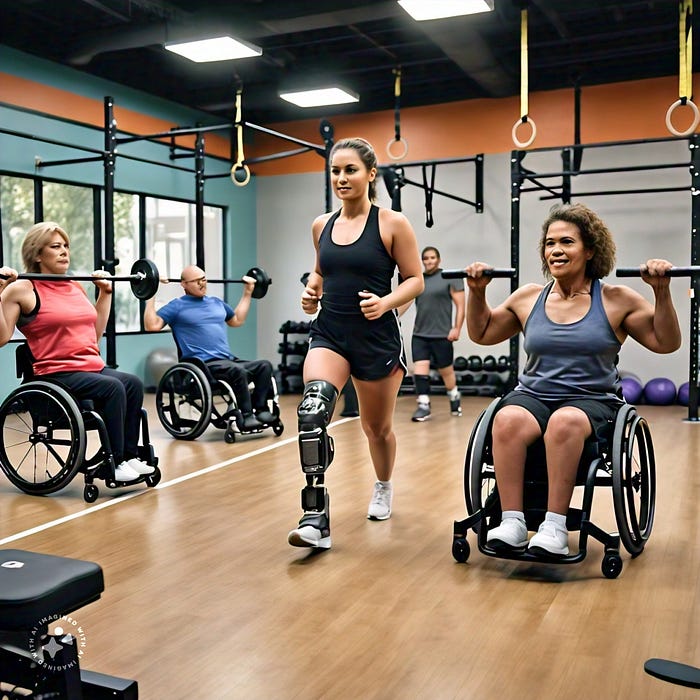🌟🏋️♂️Adaptive Fitness: Inclusive Workouts for All Abilities

In the realm of fitness, the word “inclusive” is often spoken, but what does it truly mean? Inclusive fitness is about ensuring that everyone, regardless of their abilities or disabilities, can participate in physical activity. Adaptive fitness opens doors for individuals with disabilities, providing them with the opportunity to engage in workouts tailored to their needs. It’s a world where everyone can thrive, pushing boundaries and shattering limitations. This article delves into adaptive workout plans, insights from adaptive athletes, and the growing landscape of accessible fitness facilities.
The Essence of Adaptive Fitness
Adaptive fitness is the art and science of modifying traditional exercises to meet the needs of individuals with physical, sensory, or cognitive disabilities. It’s about innovation, creativity, and understanding that fitness is a right for all, not a privilege for some.
Why Adaptive Fitness Matters
- Physical Health Benefits: Regular exercise helps in improving cardiovascular health, muscle strength, flexibility, and overall physical endurance.
- Mental Health Advantages: Exercise is a proven mood booster, reducing symptoms of anxiety and depression, and enhancing self-esteem.
- Social Inclusion: Fitness activities promote social interaction, reducing feelings of isolation and fostering a sense of community.
Crafting Adaptive Workout Plans

Creating effective adaptive workout plans involves understanding the unique needs and capabilities of individuals. Here are some adaptive exercises tailored for different abilities:
1. Wheelchair-Based Workouts
Cardio Exercises: Activities like wheelchair basketball, hand cycling, or simply propelling the wheelchair at varying speeds can provide excellent cardiovascular workouts.
Strength Training: Using resistance bands or lightweight dumbbells, individuals can perform upper body exercises such as shoulder presses, bicep curls, and tricep extensions.
2. Visual Impairment Adaptations
Tactile and Audio Cues: Utilizing tactile markers on equipment and audio instructions can help guide individuals through workouts safely.
Balance and Coordination: Exercises such as modified yoga or balance drills using stability balls and balance boards can enhance stability and coordination.
3. Cognitive Disabilities
Structured Routine: Consistency and routine are key. Structured and repetitive exercises can help individuals feel more comfortable and confident.
Engaging Activities: Fun, engaging activities like dance workouts or interactive fitness games can motivate participation and enjoyment.
Click Here to Claim Your Free Bonus of Refreshing Tea Remedies
Accessible Fitness Facilities: Bridging the Gap

Creating inclusive fitness environments involves more than just equipment; it’s about fostering an inclusive culture and providing the necessary support.
1. Adaptive Equipment
Modern gyms are increasingly equipped with adaptive machines and tools, such as hand cycles, seated ellipticals, and resistance bands, ensuring everyone can engage in a full workout.
2. Trained Staff
Having knowledgeable and empathetic staff is crucial. Fitness trainers who are trained in adaptive techniques and disability awareness can make a significant difference in creating an inclusive environment.
3. Inclusive Programs
Gyms and fitness centers are offering more inclusive programs, such as adaptive yoga, wheelchair sports leagues, and personalized training sessions tailored to individual needs.
Building a Supportive Community
Adaptive fitness is not just about individual workouts; it’s about building a supportive and inclusive community. Here are ways to foster such an environment:
1. Peer Support Groups
Forming peer support groups can provide individuals with a sense of camaraderie and shared experience. These groups can meet regularly to exercise together, share tips, and offer encouragement.
2. Adaptive Sports Teams
Joining adaptive sports teams can be a fantastic way for individuals to stay active, build teamwork skills, and engage in competitive sports.
3. Awareness Campaigns
Raising awareness about adaptive fitness through campaigns, workshops, and social media can help break down barriers and promote inclusivity in the fitness world.
The Future of Adaptive Fitness

The landscape of adaptive fitness is evolving, with technology playing a significant role. Innovations such as virtual reality workouts, advanced prosthetics, and adaptive fitness apps are making it easier for individuals with disabilities to engage in fitness activities from anywhere.
Virtual Reality Workouts
Virtual reality (VR) offers immersive workout experiences tailored to individual needs. Whether it’s a guided yoga session or a high-intensity interval training (HIIT) workout, VR can provide an engaging and accessible fitness solution.
Advanced Prosthetics
Advancements in prosthetic technology are enabling individuals with limb differences to participate in a wider range of physical activities. From running blades to adaptive cycling prosthetics, these innovations are breaking down physical barriers.
Adaptive Fitness Apps
Adaptive fitness apps are designed to provide tailored workout plans, tracking, and motivational support. These apps can cater to various disabilities, offering modifications and guidance to ensure effective and safe workouts.
Discover the Nature’s Secret to Accelerating Weight Loss — Click Here to Learn More
Conclusion: Embracing Inclusivity in Fitness
Adaptive fitness is about breaking down barriers and ensuring that everyone, regardless of their abilities, has the opportunity to lead a healthy and active lifestyle. By embracing inclusivity, supporting adaptive athletes, and fostering accessible environments, we can create a fitness world where everyone belongs.
Fitness is not one-size-fits-all, and by celebrating diversity and promoting adaptive fitness, we can empower individuals to achieve their health and wellness goals. Join the movement towards inclusive fitness and discover how adaptive workouts can transform lives, one exercise at a time.

Comments
Post a Comment